牛津版初中英语语法大全
- 格式:doc
- 大小:377.00 KB
- 文档页数:26
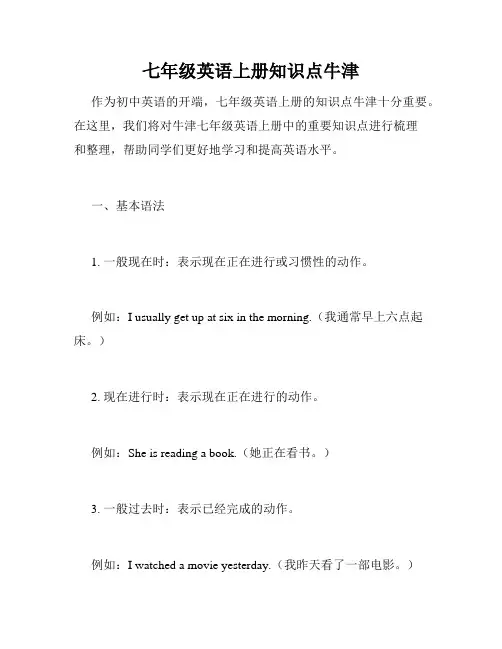
七年级英语上册知识点牛津作为初中英语的开端,七年级英语上册的知识点牛津十分重要。
在这里,我们将对牛津七年级英语上册中的重要知识点进行梳理和整理,帮助同学们更好地学习和提高英语水平。
一、基本语法1. 一般现在时:表示现在正在进行或习惯性的动作。
例如:I usually get up at six in the morning.(我通常早上六点起床。
)2. 现在进行时:表示现在正在进行的动作。
例如:She is reading a book.(她正在看书。
)3. 一般过去时:表示已经完成的动作。
例如:I watched a movie yesterday.(我昨天看了一部电影。
)4. 现在完成时:表示已经完成的动作对现在造成的影响。
例如:I have finished my homework.(我已经完成了我的作业。
)5. 现在完成进行时:表示从过去某时开始一直到现在正在进行的动作。
例如:I have been studying English for two hours.(我已经学了两个小时的英语。
)二、基本词汇1. 数字:one, two, three, four, five, six, seven, eight, nine, ten2. 人称代词和物主代词:I, you, he, she, it, we, they, me, you, him, her, it, us, them3. 颜色:red, blue, green, yellow, black, white4. 学科:math, science, history, geography, music, art, PE三、基本句型1. 陈述句:主语 + 谓语 + 宾语例如:I love English.(我爱英语。
)2. 疑问句:疑问词 + 动词 + 主语 + 其他信息例如:What is your name?(你叫什么名字?)3. 否定句:主语 + 动词 + not + 宾语例如:I do not like math.(我不喜欢数学。
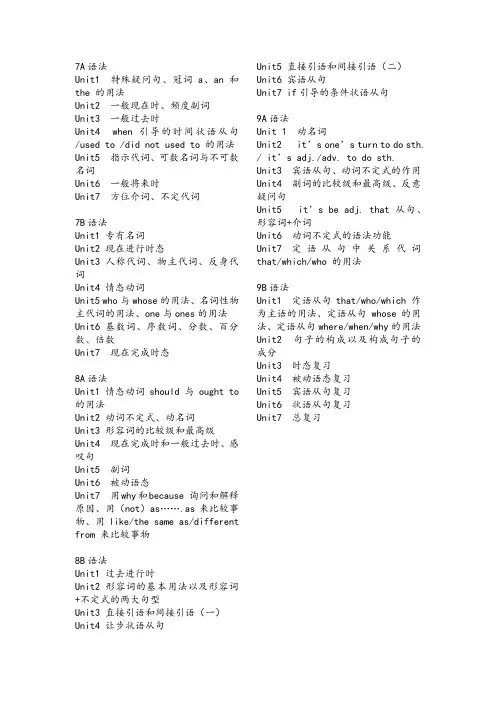


英语语法大全初中英语语法学习提纲一、词类、句子成分和构词法:1、词类:英语词类分十种:名词、形容词、代词、数词、冠词、动词、副词、介词、连词、感叹词。
1、名词(n.):表示人、事物、地点或抽象概念的名称。
如:boy, morning, bag, ball, class, orange.2、代词(pron.):主要用来代替名词。
如:who, she, you, it .3、形容词(adj..):表示人或事物的性质或特征。
如:good, right, white, orange .4、数词(num.):表示数目或事物的顺序。
如:one, two, three, first, second, third, fourth.5、动词(v.):表示动作或状态。
如:am, is,are,have,see .6、副词(adv.):修饰动词、形容词或其他副词,说明时间、地点、程度等。
如:now, very,here, often, quietly, slowly.7、冠词(art..):用在名词前,帮助说明名词。
如:a, an, the.8、介词(prep.):表示它后面的名词或代词与其他句子成分的关系。
如in, on, from, above, behind.9、连词(conj.):用来连接词、短语或句子。
如and, but, before .10、感叹词(interj..)表示喜、怒、哀、乐等感情。
如:oh, well, hi, hello.2、句子成分:英语句子成分分为七种:主语、谓语、宾语、定语、状语、表语、宾语补足语。
1、主语是句子所要说的人或事物,回答是“谁”或者“什么”。
通常用名词或代词担任。
如:I’m Miss Green.(我是格林小姐)2、谓语动词说明主语的动作或状态,回答“做(什么)”。
主要由动词担任。
如:Jack cleansthe room every day. (杰克每天打扫房间)3、表语在系动词之后,说明主语的身份或特征,回答是“什么”或者“怎么样”。

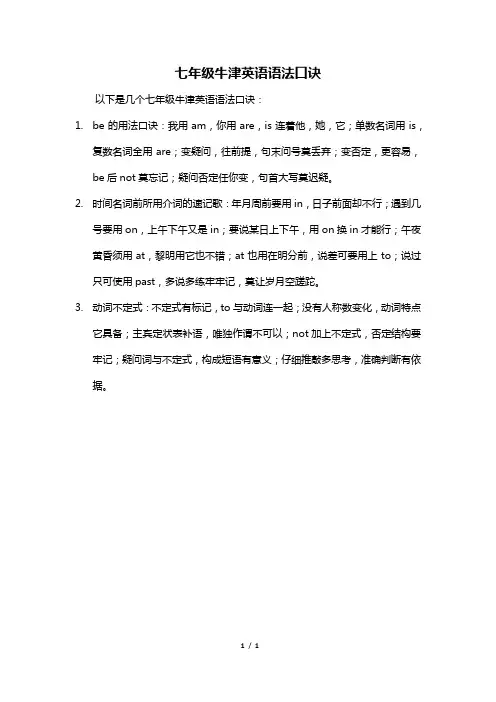
七年级牛津英语语法口诀
以下是几个七年级牛津英语语法口诀:
1.be的用法口诀:我用am,你用are,is连着他,她,它;单数名词用is,
复数名词全用are;变疑问,往前提,句末问号莫丢弃;变否定,更容易,be后not莫忘记;疑问否定任你变,句首大写莫迟疑。
2.时间名词前所用介词的速记歌:年月周前要用in,日子前面却不行;遇到几
号要用on,上午下午又是in;要说某日上下午,用on换in才能行;午夜黄昏须用at,黎明用它也不错;at也用在明分前,说差可要用上to;说过只可使用past,多说多练牢牢记,莫让岁月空蹉跎。
3.动词不定式:不定式有标记,to与动词连一起;没有人称数变化,动词特点
它具备;主宾定状表补语,唯独作谓不可以;not加上不定式,否定结构要牢记;疑问词与不定式,构成短语有意义;仔细推敲多思考,准确判断有依据。
1/ 1。

七年级英语牛津版知识点七年级英语,是初中英语的一个重要阶段。
本文将对牛津版七年级英语的知识点进行总结。
一、语法1.基本句型英语的基本句型为主语+谓语+宾语。
如:I like English. (我喜欢英语。
)2.一般现在时一般现在时表示动作或状态的现在进行或经常发生。
如:She often goes to the park on weekends. (她经常在周末去公园。
)3.一般过去时一般过去时表示过去某一时间发生的动作或状态。
如:He watched TV last night. (他昨晚看了电视。
)4.一般将来时一般将来时表示将来某一时间要发生的动作或状态。
如:I will visit my grandparents next week. (我下周会去看望我的祖父母。
)5.情态动词情态动词可以表示说话人的心情、意愿或能力等。
如:We can play basketball together. (我们可以一起打篮球。
)二、词汇1.日常生活用语学生可以学习一些日常生活用语,如问候语、询问时间、询问地址等。
如:How are you? (你好吗?)2.数字在初中英语中,学生需要学习如何用英语说和写数字。
如:twenty-three (23)3.颜色初中英语中也需要学习颜色的表达。
如:green (绿色)三、阅读理解在初中英语中,阅读理解是一个重要的环节。
学生需要阅读各种文章,从中获取信息并回答相关问题。
1.阅读短文学生可以阅读各种长度的短文,从中获取信息并进行理解。
如:Hello, my name is Mary. I live in New York with my family. I have a cat named Ginger. He is very cute. I like to play with him.2.问答题问答题是英语阅读理解中的一个重要环节。
学生需要根据文章提出的问题,回答相关问题。
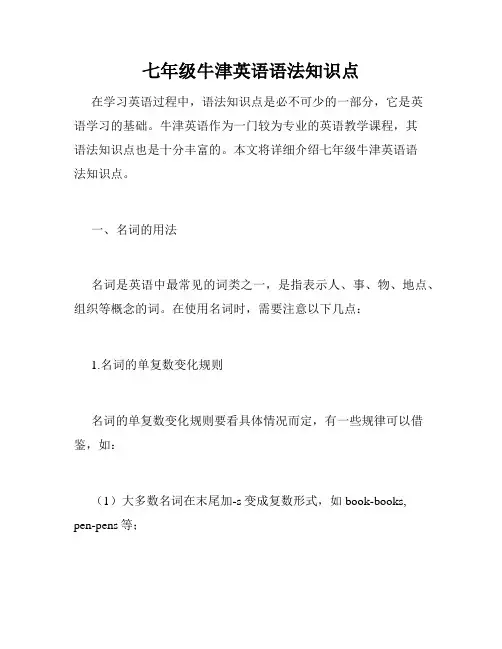
七年级牛津英语语法知识点在学习英语过程中,语法知识点是必不可少的一部分,它是英语学习的基础。
牛津英语作为一门较为专业的英语教学课程,其语法知识点也是十分丰富的。
本文将详细介绍七年级牛津英语语法知识点。
一、名词的用法名词是英语中最常见的词类之一,是指表示人、事、物、地点、组织等概念的词。
在使用名词时,需要注意以下几点:1.名词的单复数变化规则名词的单复数变化规则要看具体情况而定,有一些规律可以借鉴,如:(1)大多数名词在末尾加-s变成复数形式,如book-books,pen-pens等;(2)以x、s、sh、ch结尾的名词在末尾加-es变成复数形式,如box-boxes, bus-buses等;(3)以f、fe结尾的名词通常将f、fe改成ves变成复数形式,如leaf-leaves, knife-knives等;(4)有些名词是不规则的,如man-men, foot-feet等。
2.名词的所有格形式表示“某人的或某物的部分或全部”时,通常要使用名词的所有格形式。
其构成方法如下:(1)如果名词是单数,一般在末尾加‘s表示所有格形式,如Tom’s book;(2)如果名词是复数,且末尾已经是-s,则只需在末尾加一个撇号(’)表示所有格形式,如the boys’ school;(3)如果名词是复数,但不以-s结尾,则在末尾加‘s构成所有格形式,如the children’s toys。
二、代词的用法代词是指代其他名词、代表某些特定的人或事物的词。
在使用代词时,需要注意以下几点:1.代词的种类代词可以分为人称代词(如I、you、he、she、it、we、they)、指示代词(如this、that、these、those)、不定代词(如some、any、no、every、each、few、many、several等)以及相对代词(如who、whom、whose、which、that等)等。
2.代词的使用方法在使用代词时,需要根据具体语境来决定使用哪种代词。

补充:1.句子的构成初中一年级上语法1.in;on;at表示时间的应用in +parts of dayevening;morning;etc /month/season/yearon + day Sunday; etc/date1 July;etc/parts of a special day Sunday morning/special holidaysChildren’s Dayat + time of day seven o’clock/ age6 years old2.频率副词never; seldom;sometimes;often;usually;always3.疑问副词的用法what;which;who;whose;when;why;how4.可数名词与不可数名词5.some和any的用法6.There be句型7.现在进行时及动词+ing的用法初中一年级下语法1.序数词与基数词2.一般将来时:will与shall、be going to3.名词所有格名字+’s;mine;yours;ours;theirs;his;hers;its4.冠词 a;an; the的用法5.表示方位的介词In front of; behind;inside;outside;above;below;over;under6.一般过去式及过去分词+ed的用法7.can;could;may的用法8.What 和 How开头的感叹句9形容词的用法;在句子中的位置10.不定代词的用法Somebody; someone; somethingAnybody; anyone; anythingNobody; no one; nothingEverybody; everyone; everthing初中二年级上语法1.比较级、最高级的用法than作为比较级、the+最高级的用法+er 及+est 的用法;most+形容词表示最高级2. more…than; fewer….than;less..than; the most; the fewest; the least的用法3. as…as的用法4.反身代词的用法Myself; yourself; himself; herself; itself; ourselves; yourselves; themselves5.祈使句的用法肯定:Open the door.否定:Don’t close the window.礼貌些:Please….6.表示建议 should和had better的用法7.may来表示可能性的用法区别初一下7;may作为询问语气的用法8.不定式用法9.用不定式表示目的;用 in order to表示目的10. A.“动词+宾语+不定式”结构;即;动词+宾语+to do不定式可用这类结构的常用动词有 advise; allow; ask; bear; beg; bother; cause; command; determine; encourage; expect; forbid; force; get; hate; help; intend; invite; leave; like; mean; need; order; permit; persuade; prefer; request; remind; request; teach; tell; trouble; want; warn; wish等..B.不需要加to的动词:使役动词:make; let等感官动词:see; hear等关于各种动词的用法;后续有专题讲解11.句型:主语+谓语主语+谓语+宾语主语+谓语+表语主语+谓语+间接宾语+直接宾语主语+谓语+直接宾语+间接宾语12.过去进行时13.when; while; as的用法及区别初中二年级下语法1.现在完成时 Unit12.have /has been与have /has gone 区别 Unit23. 一般过去时;过去完成时 Unit34.疑问词+不定式 Unit4What to…Who to…When to…Where to…Which to…How to…5.Be enough to:to be+adj.+enough+不定式Too...to:To be + too +adj.+不定式 unit56. It is+adj.+for+不定式 Unit6It is+adj+of+不定式7.被动语态及其在一般现在时和一般过去时中的应用 Unit78.被动语态在一般将来时中的应用 Unit8。
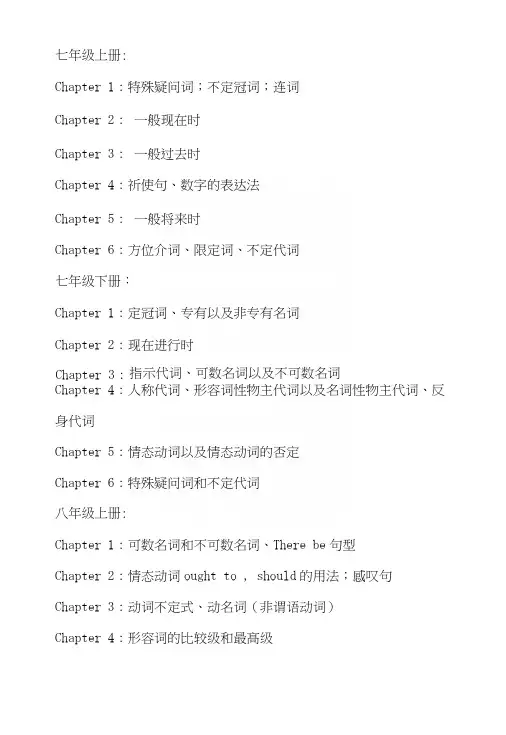
七年级上册:Chapter 1:特殊疑问词;不定冠词;连词Chapter 2:一般现在时Chapter 3:一般过去时Chapter 4:祈使句、数字的表达法Chapter 5:一般将来时Chapter 6:方位介词、限定词、不定代词七年级下册:Chapter 1:定冠词、专有以及非专有名词Chapter 2:现在进行时Chapter 3:指示代词、可数名词以及不可数名词Chapter 4:人称代词、形容词性物主代词以及名词性物主代词、反身代词Chapter 5:情态动词以及情态动词的否定Chapter 6:特殊疑问词和不定代词八年级上册:Chapter 1:可数名词和不可数名词、There be句型Chapter 2:情态动词ought to , should的用法;感叹句Chapter 3:动词不定式、动名词(非谓语动词)Chapter 4:形容词的比较级和最髙级Chapter 5:现在完成时Chapter 7:被动语态八年级下册:Chapter 1: if/unless引导的条件状语从句Chapter 2:形容词深入学习Chapter 3: why/because 的用法;as...as…的比较结构Chapter 4:目的/结果/让步状语从句Chapter 5:过去进行时Chapter 6:定语从句Chapter 7:间接引语九年级全一册:Chapter 1:零冠词;What kind (sort) of句式;学习定语Chapter 2:形容词的四种不同用法*It is adj. for sb to do sth*It is adj of sb to do sth*・・・enough to do sth*形容词的ing和ed形式Chapter 3: it 的用法可指时间、季节、天气或者距离也可以用做形式主语,代替后面的动词不定式或动名词还可以指代前面提过的的第三人称单数的物Chapter 4:过去完成时的基本结构和语法含义,还有标志词引导的让步状语从句Chapter 6: have to 和need to 的区别在know, think, believe等后面用that引导的宾语从句Chapter 7:带有特殊疑问词的宾语从句。

牛津初中英语语法1人称代词主格I, you, he, she, it, we, you, they宾格me, you, him, her, it, us, you, them2物主代词形容词性my, your, his, her, its, our, their名词性mine, yours, his, hers, its, ours, theirs3反身代词myself, yourself, himself, herself, itself, ourselves, yourselves, themselves 4指示代词this, that, these, those, such, some5疑问代词who, whom, whose, which, what, whoever, whichever, whatever6关系代词that, which, who, whom, whose, as7不定代词one/ some/ any, each/ every, none/ no, many/ much, few/ little/ a few/ a little, other/ another, all/ both, neither/ eitherII. 不定代词用法注意点:1. one, some与any:1) one可以泛指任何人,也可特指,复数为ones。
some多用于肯定句,any多用于疑问句和否定句。
One should learn to think of others.Have you any bookmarks? No, I don’t have any bookmarks.I have some questions to ask.2) some可用于疑问句中,表示盼望得到肯定的答复,或者表示建议,请求等。
Would you like some bananas? Could you give me some money?3) some 和any修饰可数名词单数时,some表示某个,any表示任何一个。
初中英语知识点总结牛津版一、词汇与短语1. 基础词汇- 常见名词:家庭成员、学校科目、日常用品、颜色、数字、天气等。
- 动词:一般现在时、一般过去时、现在进行时的常用动词。
- 形容词和副词:描述人、物、地点的特征及其程度。
- 代词:人称代词、物主代词、反身代词、指示代词等。
2. 短语搭配- 动词短语:如“take off”(起飞)、“look after”(照顾)等。
- 介词短语:如“in time”(及时)、“at the moment”(此刻)等。
- 常用表达:问候、告别、请求、邀请、道歉等日常交际用语。
二、语法知识1. 时态- 一般现在时:表示习惯性动作或普遍真理。
- 一般过去时:描述过去发生的动作或状态。
- 现在进行时:表示正在进行的动作。
- 一般将来时:表达将来会发生的动作或计划。
2. 语态- 被动语态:强调动作的承受者,而非执行者。
3. 非谓语动词- 动名词:作为名词使用,可以作主语、宾语等。
- 分词:现在分词和过去分词,用作形容词或副词。
- 不定式:作为名词、形容词、副词等。
4. 句子结构- 简单句:一个主语和谓语构成的句子。
- 并列句:用并列连词连接的两个或多个简单句。
- 复合句:包含主句和从句的复杂句子。
5. 从句- 名词性从句:包括主语从句、宾语从句、表语从句和同位语从句。
- 定语从句:修饰名词或代词的从句,由关系代词或关系副词引导。
- 状语从句:表示时间、地点、原因、条件、结果等,由从属连词引导。
三、阅读理解1. 阅读技巧- 快速阅读:通过扫读抓住文章大意。
- 精读:深入理解文章细节和深层含义。
- 推理判断:根据上下文推断生词或隐含信息。
2. 阅读题型- 事实细节题:寻找文章中的具体信息。
- 主旨大意题:确定文章的主要观点或目的。
- 推理判断题:根据文章内容进行逻辑推理。
- 词义猜测题:猜测生词或短语的含义。
四、写作技巧1. 文章结构- 引言:开篇引入话题,提出观点或问题。
牛津初中英语语法1人称代词主格I, you, he, she, it, we, you, they宾格me, you, him, her, it, us, you, them2物主代词形容词性my, your, his, her, its, our, their名词性mine, yours, his, hers, its, ours, theirs3反身代词myself, yourself, himself, herself, itself, ourselves, yourselves, themselves 4指示代词this, that, these, those, such, some5疑问代词who, whom, whose, which, what, whoever, whichever, whatever6关系代词that, which, who, whom, whose, as7不定代词one/ some/ any, each/ every, none/ no, many/ much, few/ little/ a few/ a little, other/ another, all/ both, neither/ eitherII. 不定代词用法注意点:1. one, some与any:1) one可以泛指任何人,也可特指,复数为ones。
some多用于肯定句,any多用于疑问句和否定句。
One should learn to think of others.Have you any bookmarks? No, I don’t have any bookmarks.I have some questions to ask.2) some可用于疑问句中,表示盼望得到肯定的答复,或者表示建议,请求等。
Would you like some bananas? Could you give me some money?3) some 和any修饰可数名词单数时,some表示某个,any表示任何一个。
一、基本语法知识:1.句子和句子成分:-句子由主语和谓语组成,主语通常是一个名词或代词,谓语是一个动词。
-一个句子可以包含其他成分,如宾语、定语、状语等。
2.名词:-名词可以指人、物、地方、动物等。
-名词有单数和复数形式,一般情况下,单数名词加-s来表示复数。
- 名词还有可数和不可数之分,可数名词可以用a或an来修饰,不可数名词通常不加冠词。
3.形容词:-形容词用来描述名词的特征或特性。
-形容词有比较级和最高级,比较级用于比较两个人或物的不同,最高级用于三个或三个以上的人或物的比较。
4.代词:- 代词用来代替名词,如主格代词(I、you、he/she/it等)、宾格代词(me、you、him/her/it等)、物主代词(my、your、his/her/its 等)等。
5.动词:-动词用来表示动作或状态。
-动词有时态的变化,如现在时(一般现在时、现在进行时)、过去时(一般过去时)等。
-动词有人称的变化,如第三人称单数动词在一般现在时加-s。
6.副词:-副词用来修饰动词、形容词或其他副词,表示时间、地点、方式等。
-副词有比较级和最高级。
7.介词:-介词用来表示时间、地点、方向、目的等关系。
- 常用的介词有at、in、on、by、about、for等。
8.冠词:-冠词用来限定名词的范围,分为定冠词和不定冠词。
- 定冠词是"the",不定冠词是"a"或"an"。
9.祈使句:-祈使句用来表示请求、建议、命令等,一般省略主语,动词用原形。
二、词汇:1.常用动词:- be(am、is、are)、have、do、go、get、like、want、see、make、eat、drink等。
2.与家庭有关的词汇:- family、mother、father、brother、sister、grandfather、grandmother、uncle、aunt等。
深圳牛津初中英语语法总汇■名词(一)概述名词是表示人、地方、事物或抽象概念名称的词,可以说名词是万物之名称。
它们可以是:人的名字Li Ming, Tom 地方名称China, London 职业称呼teacher, doctor物品名称pencil, dictionary 行为名称study, invention 抽象概念history, grammar(二)普通名词和专有名词1.普通名词凡不属于特定的人名、地名、事物名称或概念名称的名词,都属于普通名词。
这类名词在所有的名词中占绝大多数。
普通名词大致有以下四种类型:1)个体名词个体名词指作为个体而存在的人或物。
可以指具体的人或物,例如:He has two aunts. 他有两个姑姑。
Most classrooms have computers. 多数教室里都有电脑。
也可指抽象东西,例如:We’ve lived here for twenty years. 我们在这里住了二十年了。
I had a dream last night 我昨晚做了一个梦。
个体名词有复数形式,如:weeks, problems;单数形式可以和a/an连用,如:a week, a problem, an old man.2)集体名词集体名词表示由个体组成的集体,下面是一些常见的集体名词:family(家,家庭)army(军队)company(公司;全体船员)enemy(敌人)government (政府)group(小组,团体)public(公众)team(队;组)police(警方)集体名词有时作单数看待,有时作复数看待。
一般说来,视为整体时作单数看待,例如:有的集体名词通常用作单数,例如:Our company is sending him to work in Berlin. 我们公司将派他去柏林工作。
有的集体名词多作复数看待。
例如:The police are looking for him. 警察正在找他。
英语语法大全初中英语语法学习提纲一、词类、句子成分和构词法:1、词类:英语词类分十种:名词、形容词、代词、数词、冠词、动词、副词、介词、连词、感叹词。
1、名词(n.):表示人、事物、地点或抽象概念的名称。
如:boy, morning, bag, ball, class, orange.2、代词(pron.):主要用来代替名词。
如:who, she, you, it .3、形容词(adj..):表示人或事物的性质或特征。
如:good, right, white, orange .4、数词(num.):表示数目或事物的顺序。
如:one, two, three, first, second, third, fourth.5、动词(v.):表示动作或状态。
如:am, is,are,have,see .6、副词(adv.):修饰动词、形容词或其他副词,说明时间、地点、程度等。
如:now, very,here, often, quietly, slowly.7、冠词(art..):用在名词前,帮助说明名词。
如:a, an, the.8、介词(prep.):表示它后面的名词或代词与其他句子成分的关系。
如in, on, from, above, behind.9、连词(conj.):用来连接词、短语或句子。
如and, but, before .10、感叹词(interj..)表示喜、怒、哀、乐等感情。
如:oh, well, hi, hello.2、句子成分:英语句子成分分为七种:主语、谓语、宾语、定语、状语、表语、宾语补足语。
1、主语是句子所要说的人或事物,回答是“谁”或者“什么”。
通常用名词或代词担任。
如:I’m Miss Green.(我是格林小姐)2、谓语动词说明主语的动作或状态,回答“做(什么)”。
主要由动词担任。
如:Jack cleansthe room every day. (杰克每天打扫房间)3、表语在系动词之后,说明主语的身份或特征,回答是“什么”或者“怎么样”。
牛津译林英语初中三年(七年级——九年级)语法知识总结7A语法Unit 1 This is me!一般现在时(be)am, is, are1.一般现在时的定义表示主语具备的性格、能力、特征和状态2. 结构:肯定句:主语 + be + ...否定句:主语 + be + not +...一般疑问句及回答: be + 主语 + ...?(肯定回答)Yes, 主语 be. (否定回答)No,主语 be not(aren’t, isn’t).3.一般现在时中be动词的使用。
(一)be动词:动词be (am, is, are)说明身份、年龄、状态等(二)be动词的人称变化:第一人称I,后面的动词用am;第三人称he/she/it, 后面的动词用is;第一人称复数we, 第二人称you, 第三人称复数they,后面的动词用are.(三)be 动词在一般疑问句和否定句中的表达:动词be一般现在时的一般疑问句,把be提到句首,它的否定句式是在be后直接加not。
(四)be 动词的具体使用:1.be + 形容词2. be + 名词3. be + 介词短语4. be + 形容词短语5. be +副词6. 用于表示时间:Unit 2 Let’s play sports!一般现在时(do)1. 定义:表示经常的或习惯性的动作;表示客观真理或事实;表示目前的爱好、能力。
2. 常见时间短语:often, sometimes, usually, always, every week, on Sundays, once a month 等3. 结构:肯定句:主语 +V. + ...否定句:主语 + do/ does+ not + V. +...一般疑问句及回答: Do/Does + 主语 + ...?(肯定回答)Yes, 主语 do/ does. (否定回答)No,主语 do/does not(don’t, doesn’t).4. 第三人称单数形式及其变化规则当主语是第三人称单数时,谓语动词要用第三人称单数形式(三单)动词变化规则:(1).规则动词 + s,如makes, eats(2).s,sh,ch, ss, x 结尾 + es,如teaches, misses, fixes, finishes(3).辅音字母 + y结尾,把y 改为 ies,如carries, cries(4).特殊变化,如go--- goes, do --- does, have--- hasUnit 3 Welcome to our school!人称代词1. 定义:代替人或物的名词2. 人称代词的主宾格在句子中做的成分(1)人称代词的主格在句子中做主语,一般位于句首。
牛津版初中英语语法大全牛津初中英语语法三.代词:I. 代词可以分为以下七大类:1人称代词主格I, you, he, she, it, we, you, they宾格me, you, him, her, it, us, you, them2物主代词形容词性my, your, his, her, its, our, their名词性mine, yours, his, hers, its, ours, theirs3反身代词myself, yourself, himself, herself, itself, ourselves, yourselves, themselves 4指示代词this, that, these, those, such, some5疑问代词who, whom, whose, which, what, whoever, whichever, whatever6关系代词that, which, who, whom, whose, as7不定代词one/ some/ any, each/ every, none/ no, many/ much, few/ little/ a few/ a little,other/ another, all/ both, neither/ eitherII. 不定代词用法注意点:1. one, some与any:1) one可以泛指任何人,也可特指,复数为ones。
some多用于肯定句,any多用于疑问句和否定句。
One should learn to think of others.Have you any bookmarks? No, I don’t have any bookmarks.I have some questions to ask.2) some可用于疑问句中,表示盼望得到肯定的答复,或者表示建议,请求等。
Would you like some bananas? Could you give me some money?3) some 和any修饰可数名词单数时,some表示某个,any表示任何一个。
I have read this article in some magazine. Please correct the mistakes, if any.4) some和数词连用表示“大约”,any可与比较级连用表示程度。
There are some 3,000 students in this school. Do you feel any better today?2. each和every:each强调个别,代表的数可以是两个或两个以上,而every强调整体,所指的数必须是三个或三个以上。
Each student has a pocket dictionary. / Each (of us) has a dictionary. / We each have a dictionary.Every student has strong and weak points. / Every one of us has strong and weak points.3. none和no:no等于not any,作定语。
none作主语或宾语,代替不可数名词,谓语用单数,代替可数名词,谓语单复数皆可以。
There is no water in the bottle.How much water is there in the bottle? None.None of the students are (is) afraid of difficulties.4. other和another:1) other泛指“另外的,别的”常与其他词连用,如:the other day, every other week, some other reason, no other way,the other特指两者中的另外一个,复数为the others。
如:He held a book in one hand and his notes in the other.Two students in our class failed, but all the others passed the exam.2) another指“又一个,另一个”无所指,复数形式是others,泛指“别的人或事”如:I don’t like this shirt, please show me another (one).The trousers are too long, please give me another pair / some others.Some like football, while others like basketball.5. all和both, neither和eitherall表示不可数名词时,其谓语动词用单数。
both和all加否定词表示部分否定,全部否定用neither和none.All of the books are not written in English. / Not all of the books are written in English.Both of us are not teachers. / Not both of us are teachers. / Either of us is a teacher.四.形容词和副词I. 形容词:1. 形容词的位置:1) 形容词作定语通常前置,但在下列情况后置:1修饰some, any, every, no和body, thing, one等构成的复合不定代词时nobody absent, everything possible2以-able, -ible结尾的形容词可置于有最高级或only修饰的名词之后the best book available, the onlysolution possible3alive, alike, awake, aware, asleep等可以后置the only person awake4和空间、时间、单位连用时 a bridge 50 meters long5成对的形容词可以后置 a huge room simple and beautiful 6形容词短语一般后置 a man difficult to get on with2) 多个形容词修饰同一个名词的顺序:代词数词性状形容词冠词前的形容词冠词指示代词不定代词代词所有格序数词基数词性质状态大小长短形状新旧温度颜色国籍产地材料质地名词all both such theathisanotheryoursecondnextonefourbeautifulgoodpoorlargeshortsquarenewcoolblackyellowChineseLondonsilkstone3) 复合形容词的构成:1形容词+名词+ed kind-hearted6名词+形容词world-famous 2形容词+形容词dark-blue7名词+现在分词peace-loving 3形容词+现在分词ordinary-looking8名词+过去分词snow-covered 4副词+现在分词hard-working9数词+名词+ed three-egged 5副词+过去分词newly-built10数词+名词twenty-year II. 副词副词的分类:原形作,后面一般不跟时间状语bell rang.The meeting is about to close.5be to + 动词原形表示按计划进行或征求对方意见We’re to meet at the school gate at noon.6一般现在时表示将来时刻表上或日程安排上早就定好的事情,可用一般现在时表示将来The meeting starts at fiveo’clock.The plane leaves at ten thisevening.II. 动词的被动语态:常用被动语态构成常用被动语态构成1一般现在时am/is/are asked6过去进行时was/were being asked2一般过去时was/were asked7现在完成时have/has been asked3一般将来时shall/will be asked8过去完成时had been asked4过去将来时should/would be asked9将来完成时will/would have been asked 5现在进行时am/is/are being asked10含有情态动词的can/must/may be asked注意事项被动语态的否定式是在第一个助动词或情态动词后加not,短语动词的被动态不可漏掉其中介副词。
固定结构begoing to, used to, have to, had better变为被动态时,只需将其后的动词变为被动态。
如:Trees should not be planted in summer. / The boy was made fun of by his classmates. Newspapers used to be sent here by the little girl.汉语有一类句子不出现主语,在英语中一般可用被动结构表示。
如:It is believed that…It is generally considered that…It is said that…It is well known that…It must be pointed out that…It is supposed that…It is reported that…It must be ad mitted that…It is hoped that…下面主动形式常表示被动意义:如:The window wants/needs/requires repairing. The book is worth reading twice.The door won’t shut. / The play won’t act.The clothes washes well. / The book sells well.The dish tastes delicious. / Water feels very cold.下面词或短语没有被动态:leave, enter, reach, become, benefit, cost, equal, contain, last, lack, fit, fail, have, appear, happen, occur, belong to, take place, break out, come about, agree with, keep up with, consist of, have on, lose heart等等七.情态动词I. 情态动词基本用法:情态动词用法否定式疑问式与简答can 能力(体力,智力,技能)允许或许可(口语中常用)可能性(表猜测,用于否定句或疑问句中)can not / cannot/can’t doCan…do…?Yes,…can.No,…can’t.could couldn’t domay可以(问句中表示请求)可能,或许(表推测)祝愿(用于倒装句中)may not doMay…do…? Yes,…may.No,…mustn’t/can’t.might might not do Might…do…? Yes,…might No,…might not.must 必须,应该(表主观要求)肯定,想必(肯定句中表推测)must not/mustn’t doMust…do…? Yes,…must.No,…needn’t/don’t have to.have to 只好,不得不(客观的必须,有时态人称变化)don’t have to doDo…have to do…?Y es,…do.No,…don’t.ought to 应当(表示义务责任,口语中多用shouldought notto/oughtn’t to doOught…to do…?Yes,…ought. No,…oughtn’t.shall 将要,会用于一三人称征求对方意见用于二三人称表示许诺、命令、警告、威胁等shall not/shan’t doShall…do…?Yes,…shall.No,…shan’t.should 应当,应该(表义务责任)本该(含有责备意味)sh ould not/shouldn’tdoShould…do…?will意愿,决心请求,建议,用在问句中would比较委婉will not/won’t doWill…do…?Yes,…will.No,…won’t.would would not/wouldn’t dodare敢(常用于否定句和疑问句中)dare not/daren’t do Dare…do…? Yes,…dare. No,…daren’t.need 需要必须(常用于否定句和疑问句中)need no t/needn’t doNeed…do…?Yes,…must. No,…needn’t.used to过去常常(现在已不再)usednot/usedn’t/usen’t tododidn’t use to doUsed…to do…?Yes,…used.No,…use(d)n’t.Did…use to do…?Yes,…did.No,…didn’t.II. 情态动词must, may, might, could, can表示推测:以must为例。